Gerd Heuschmann in Australia
Story – Chris Hector Photos – Roz Neave
Back in 2005, Australians were introduced to the philosophy and research of Gerd Heuschmann at the FEI VIII Regional Forum. It was an exciting first taste of Gerd’s passionate defence of horses and dressage…
Dr Gerd Heuschmann after completing his training as a professional horse trainer at Warendorf, went on to complete a veterinary degree. He now combines both skills running a vet practice and also conducting courses at Warendorf for the professional riders who are making their bereitership. Most recently, Gerd has been an articulate critic of the ‘new’ dressage training methods, and a defender of the old classical ways. He arrived in Australia not long after conducting a seminar in Canada with Klaus Balkenhol, and reports of a ‘good tsunami’ circling the globe of dressage fans who say ‘enough is enough!’
Gerd is a brilliant speaker and is incredibly passionate about his topic; he had the huge crowd so involved that they were hanging on every word.
“Horsemanship is something that many people don’t understand at all. There is no time to discuss the entire issue of horsemanship but we should try to look into the horse…”
On the screen appeared a skeleton of a horse, but one that was arranged in a very special way – in the outline of a dressage horse.
“If you think of a horse standing on four legs, then you can think of a normal bridge construction, the pillars in front, the pillars behind. The horse is naturally made to run, it is not built to carry weight by nature. That means that something has to change during the training so that the horse can do its job.”
“How can the horse deal with the weight that is naturally hanging on this bridge – about 200 to 250 kilograms, hanging on the spine. How can the horse carry the weight without damaging the spine? The answer comes from nature.”
“What is a horse-like creature – for example a Zebra – doing? It has its head and its neck down for 17 to 19 hours of the day. So what does this mean? There is between the head and the long spines, the so-called passive ligamentary system which helps the animal carry the weight. You can feel it in your horse – a ligament from the bone between the ears to the withers and on through the back ligament to the hip area. Back to the zebra, the angle is forwards / downwards and it is pulling the long spines forward and bringing up the back, so it is easy for this animal to carry the weight that is attached to the spine – there is no need for muscle effort. This is important when we are dealing with the horse.”
“We say that an untrained young horse that has not yet developed the muscle system to carry the rider’s weight, must be ridden with the ligamental system, forward and downwards to bring the back up. We all want to have a loose, swinging back, with no tension in the back muscle system – suppleness. We want to have it in the three-year-old, and we want to have it in the Grand Prix horse, all the way up. Everybody knows that sometimes you have some tension, but you should be aware that there is tension, and then do something about it.”
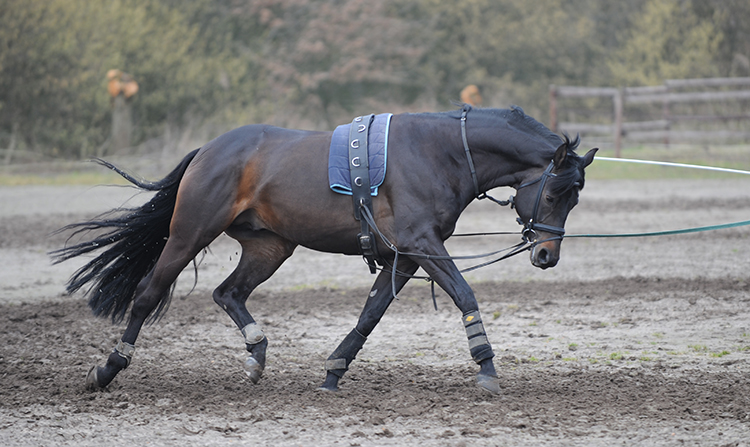
“Stretching forwards / downwards means opening this S shaped cervical spine. If you ask veterinary students, show me the cervical spine in the neck area? Most pupils will point along the top line, this is not true, it is here in the neck, a classical ‘S’. This has two advantages for us riders, it leaves a big space for a muscle system and if you ride the horse really forward and down, if you lengthen the neck, the ‘S’ opens and the neck becomes longer. This means that the tension for this ligamental system increases by driving the horse forward and down.”
At this stage Gerd had the audience in stitches with a photo of Jean Bemelmans (who also featured at the seminar) riding a bull, very deep and low. But it was quickly back to the muscle system:
“Travelling round the stables as a veterinarian, you nearly every day get to hear the lessons that the trainers are giving their pupils. Very often I hear them say ‘we have to strengthen the back muscles because this muscle has to carry the rider’s weight. But this is not true – normally the back muscle shouldn’t have much to do with carrying the rider’s weight. Why? If you watch any muscle in your body, it can only do two things – contract and expand – and a muscle can only work in one direction, in the direction the muscle fibres are flowing. The back muscle starts in the hip area and runs along the lumbar and thoracic spine, and ends at the last cervical vertebrae. This muscle is working in a horizontal way. Imagine you have a galloping horse and both hind legs are on the ground. What happens now? The long back muscle is pulling, lifting up the rump, then the horse can go into the jump phase of the gait, he is in the air in the swinging phase. This is what the long back muscle does – it is a very strong muscle for movement, and especially in the canter.”
“Once this muscle has to carry a rider, then it becomes blocked and stiff.”
“All the muscle systems work together, you cannot look at the neck without looking at the hindquarters, but to make it a bit more easy, we just go step by step.”
“Let’s think about what happens if you want to change your body – say work on your biceps with weights. But you can only do it until your muscle gets tired, then you have to put the weight down. It’s the same in a horse. When a muscle is tired there is no positive training effect. If you keep using the weights for too long, it hurts, the muscle cramps, and the training effect is zero or less than zero. We come back to this when we talk about round and deep.”
“We as riders say, okay head and neck axis is fixed with a young horse forward and downwards, now please pull forward the spines of the withers to bring up the back – this is the active system – this system is doing the same job as the neck ligament did before as the passive system. But this system can develop.”
“In Germany we have the expression relativ Aufrichtung – which means that the coming up of the horse in front is relative to education, muscle development, the increase of collection, and so on. In English it is something like relative raising of the forehand, relative to the hindquarters. The very good-looking topline of a well-trained horse shows us if the training is on the right way. This is the important muscle to bring the back up and to have it in a loose position without the necessity for the back muscle to work in an active way.”
“Please don’t do this, but it you would take off the skin of a horse, you cannot see the long back muscle. You see a white layer over the loins and in the area in which we sit – it is the back fascia which connects the long back muscles with the very strong muscle systems of the hindquarters, these are muscles that work together to flex and to stretch the haunches. But what I want to say is, if at this centre of movement, the back is not loose, then it influences the movement of the hindquarters, and because this muscle goes from the fascia through to the humerus this also influences the forearm. The natural gaits are influenced by the situation of the back.”
“Suppleness of the back is a very central topic. The natural gaits of the horse have been the way they are for a million years. For example trot – two beat, a swinging phase and diagonal movement. In trot the right forearm should be parallel to the left hind cannon bone.”
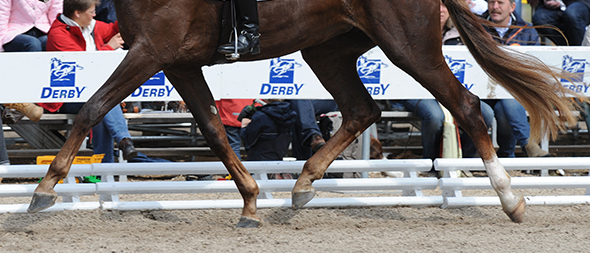

“If you don’t allow the long back muscles to swing and allow the movement to get through the poll to the horse’s mouth, then you destroy diagonal movement.
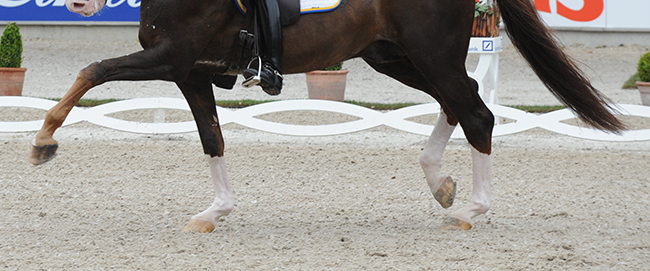

“If you block the loin area, then the front legs come out and the hind legs don’t follow. Then my question is – is this trot? If you want to discuss the marks, ask Mariette.” (Mariette Withages, then chair of the FEI dressage committee was another participant…)
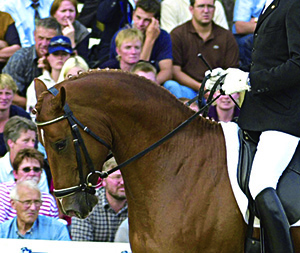

“This is my opinion is where the problem starts – this is a three-year-old horse, you can see something like this every weekend around Warendorf in each little village. A young lady with a very good seat, but she is sitting as if she is riding a dressage horse – rather short in the topline. A very nice looking topline, but the muscle system is untrained so what happens? The neck ligament is loose, there is no tension on it, it doesn’t help to carry the rider’s weight. When the horse has only been ridden for four or five months, then the muscle system is weak. To develop the muscle system takes one and a half to two years – so the horse has no alternative, it has to use the back muscle to carry the weight. If you look at a horse that has been ridden like this for ten years, you will end up with a back that is very hollow. If you take a young horse and go on training in this way, shortening the neck, never giving him the chance to develop step by step, if you make him short, you make him come up, you end up with a real problem.”
“And you end up with movement like this…”
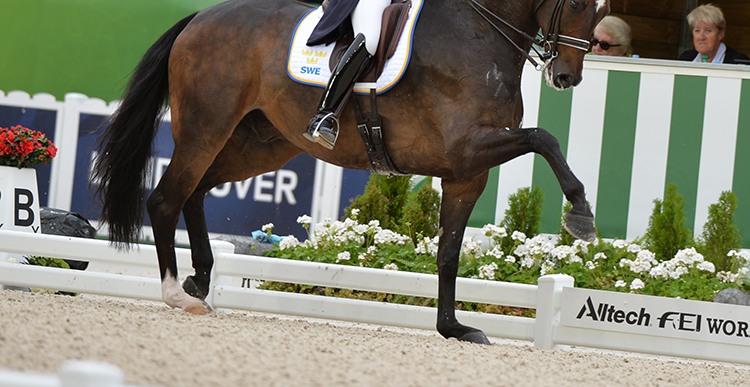

“In 1996, Ulli Schnitzer published an article in which he warned that something was happening throughout the dressage world, and he was right, it is what we see today. Horses that cannot comfortably carry the rider with their back, no flexion in the haunches, high hindquarters, short necks, and the diagonals, destroyed.”
“He said, ‘this is circus not dressage’. One of the most important first rules of our riding instruction is: keep and improve the natural gaits. There is another important directive in our riding instructions which says, especially in the young horses, ride him forward. Everyone says this when they are teaching, but no-one thinks why it is so important, especially in the young horse.”
“To understand this question we have to talk about the flexion of the haunches. The haunches are the big joints of the hindquarters, the stifle and the hock joint. Think about the trotting horse, the horse is pushing forward with its right hind leg, strengthening the leg, extending the leg – and it is the extenders that bring the movement forward, then the flexors flex the hindleg and bring the hindleg forward. When we humans extend our leg, it is straight, but with the horse because of the hock, even when it stands, the horse needs muscle power. So which muscles keep this angle? The extenders.”
“From the first beginning of the weight bearing phase, the horse must be able and willing, to place the major joints deeper, and to come out with more expression, more impulsion, with more energy. Try it yourself, flex your haunches and walk for half an hour – it’s hard work! The horse that is not trained to have strong extenders, has no chance to flex the haunches. This is why the old riding instructions say for the first two years, ride the horse forward. The old guys did this for two years, cross-country, and outside. No-body thought of taking a three year old into the indoor arena, to pull on the rein and ride it up. They gave the young athletes the chance to go forward, to strengthen the muscle systems, so they could get collection later on. This is the only real chance to get collection.”
“When you go to an international competition, what you see nowadays is this – the horse high behind.”
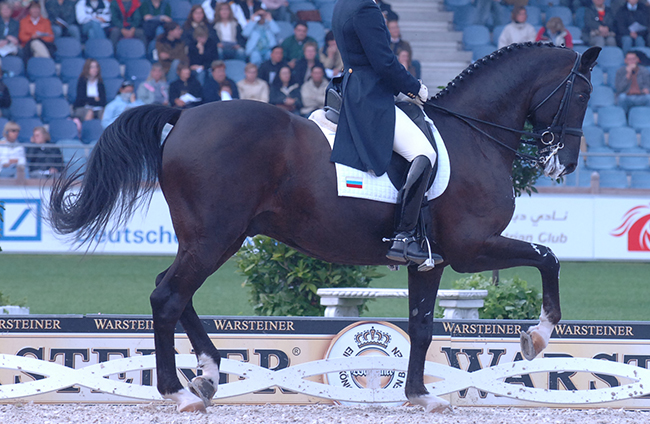
“Whatever this is – I don’t know, I don’t have a name for it…. Normally this is the point where I get too emotional. But (turning to Mme Withages and Dr Frömming) look, I slow down, I am in control, not too emotional.”
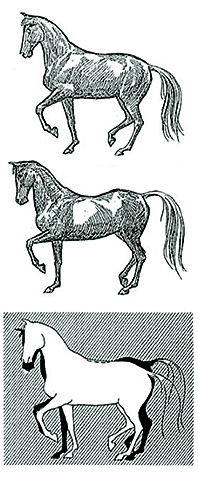
“The old riding manuals say if you want to start passage, you must have a perfect piaffe. Today if you go to an auction in Germany, you can see four-year-old horses doing something like castrated passage, it’s not trot and it’s not passage. It’s something in-between, it’s nothing – but it looks good. It looks interesting… The only people who this makes happy are the veterinarians – we can inject the back, we can inject the neck ligaments, the suspensory and the coffin joints. In these horses, the back muscle is not loose, there is no real suppleness.”
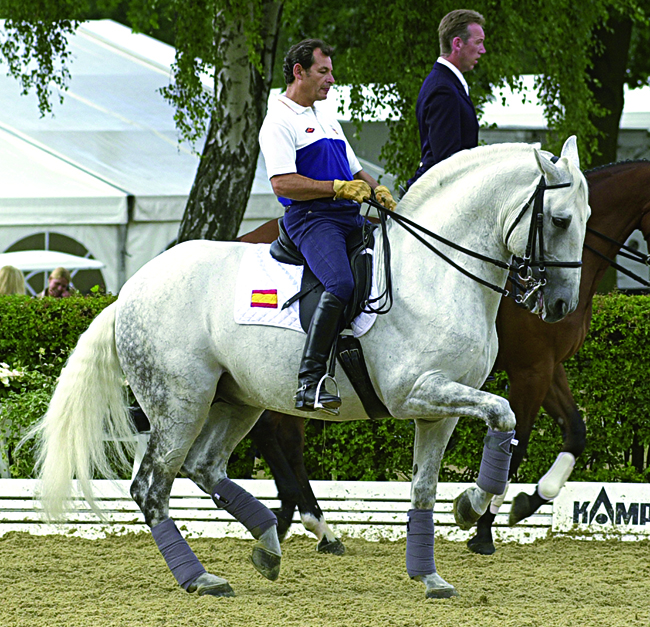
“This is piaffe…”
Fie Skarso and Media Luna
“As Jean will show you, in each training session, even with a Grand Prix horse, it should be ridden forward and long and down. It is impossible to keep a horse supple without this work. It is impossible to take a horse out of the stables and sit on it, and make him forward upwards with the rider sitting heavy in the back – you have to make the horse long, loose and swinging. If the back is not swinging, you should not sit heavy, you should try and get the back first and then sit down.”
“Another thing I want to stress, is how small the place is where we put the saddle on. Normally we sit on the long back muscle line on the ribs. The ribs join to the spine, so they move, they are flexible. But if you put the saddle too far back, then it is sitting on these transverse spines. Some dressage stables do this, using a fore-girth, and push backwards the saddle, they press on the long back muscle between the saddle and these transverse spines, they ‘fix’ the back muscle, and the horse drops down away from the pressure, and you get this wrong movement.”
“If you want to have a loose back, you want to have a supple horse, then you have to be sure, that you are not sitting on the first transverse spine. Feel it. Feel the last rib, and that is the last point where the saddle is allowed to be.”
“Now let’s talk about what you do when you pull on the reins. The joining of the head to the cervical spine is a very small area. Probably all of you have had the experience of sitting on a horse that doesn’t want to go through the poll, the horse that is pushing against your reins. Let’s look at what happens – we are pulling, even the lady riders, with 30 kilograms in each hand, the horse is pushing against the hand, not coming through. What does this mean – with which structure is the horse making this resistance? It has to pull through the top of the poll to lift its nose – so now we are looking at the arms of a lever.”
“We are pulling with 60 kilos, 30 in each hand, and the horse is pulling back with the neck ligament and the topline muscles – we are pulling over a distance of 40 cms, the horse pulls over the arm of a lever of 4 centimetres, so it has to pull with the power of 600 kilos, over the poll and with his back. If you use draw reins, then you double the energy. If you take 60 kilos on the draw reins, then you have a pull on the horse’s poll of 6000 kilos.”
“When I talk to my pupils about the way horses develop an under-neck, they say, ‘oh the horse is pushing out the under-neck’ but no it is not the horse that is doing it. If 600 kilograms is pushing backwards, the ‘S’ of the horse’s neck is squeezed together, and the lower loop is squeezed out. We do it, not the horse.”

“Now let us think about flexion. Look at the skeleton from the top. Look here where the head joins, there is a bony process, process escalacondelanus – if you flex the horse’s head, this bony process is getting close to the first vertebrae. There is only the room for one human finger, no more. If you flex more, then the horse has to flex the whole neck. What is interesting for me, is that every rule in the classical riding instruction, has an anatomical basis. It is not that some-one made up a little rulebook, and said, ‘from now on we will ride this way’. It is not the ‘German’ riding instruction, it is THE riding instruction. It follows from the body of the horse: from muscle physiology, the muscle system, everything.”
At this point, Gerd asked how much time he had left for his talk and there was a small riot from the audience at the thought he might be cut short – go on, go on, they cried, and go on he did.
“As we have seen, the strength for the horse to carry the rider does not depend on the back muscle but on the development of the ligamentary system in the neck through the top line muscle system to bring up the back and carry the rider’s weight. But there is another theory. They say that the rider’s weight is carried by the parallel pair – the back and the abdominal muscle systems, and this system is strong enough to carry the rider’s weight – and you can do whatever you want with the head and neck of the horse.”
“What is the role of the abdominal muscles? If you take a sharp pencil and push it into the abdomen of your horse, it will contract in that area, and the back will go up. This is true. Look at the racing dogs, the greyhounds, when is the back up? When the dog is in the air. The abdominal muscle is pulling forward the hip area and is making the back round. Okay a horse’s back is not so flexible, there is really a very small range of movement, but the principle is the same. When you have a cantering or galloping horse, the abdominal muscle is bringing forward the hind legs in the swinging phase. When the horse lands again, what does the body do? The horse opens again, stretching, the abdominal muscles are relaxing, and then the rider’s weight is coming to the ground.”
“Look at the long neck of the racehorse – forward, down – to bring up the rider’s weight. Think of the racehorse in slow motion, landing, opening, stretching. For me it is very clear that this abdominal muscle system is important to move the horse, especially in the canter, but it has nothing to do with carrying the weight of the rider, in a normal situation. To bring up the back, you have a supple horse, with untouched natural gaits, you need a well gymnasticised top-line, and this takes about two years of riding the horse long and forward, stretching the neck.”
“In my opinion the biggest mistakes are made in the young horses. The baby needs to be a baby. In the first year of riding, the horse needs to hack out over the fields to get used to the cars, to go up and down, to become a riding horse. In the second year, you can start to ride him a bit in the indoor, to get used to your aids. Then when you have a five year old, you have a riding horse, and then you can decide what you want to do: dressage, jumping, whatever.”
“In my opinion a dressage saddle on a three year old’s back is nonsense, like a driver’s license for a five year old kid. Keep the back free, let them go forward, let’s develop the muscle systems. What we are usually doing is making a good looking outline, we produce that by using our hands, and with our new better bred horses with better conformation, this makes it easier. A very old dressage trainer, the trainer of the Klimke family, General Paul Stecken said to me, ‘Gerd it is nice what you say, but how can you explain to our young riders that they can’t accept the wonderful necks we are producing on our young horses these days. They are not allowed to put them up and make them beautiful – they must first make them long and unspectacular…’ This is one of our biggest problems.”
Thank you…”
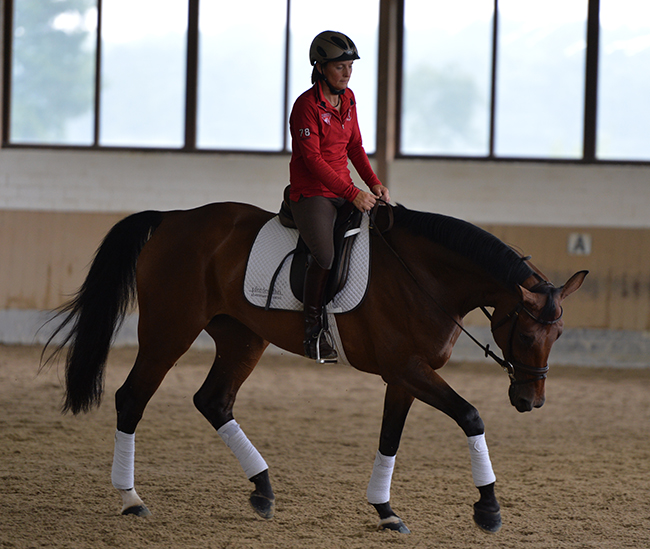

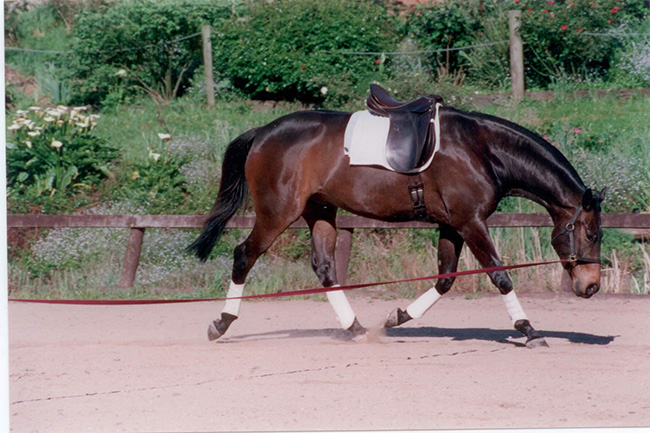
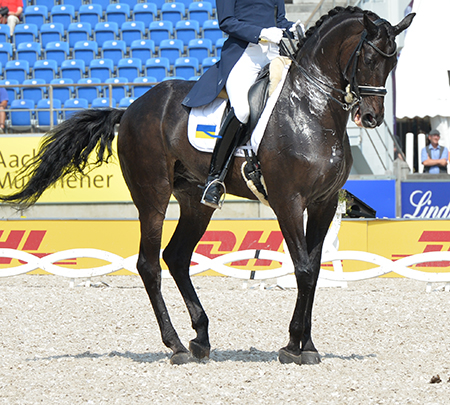
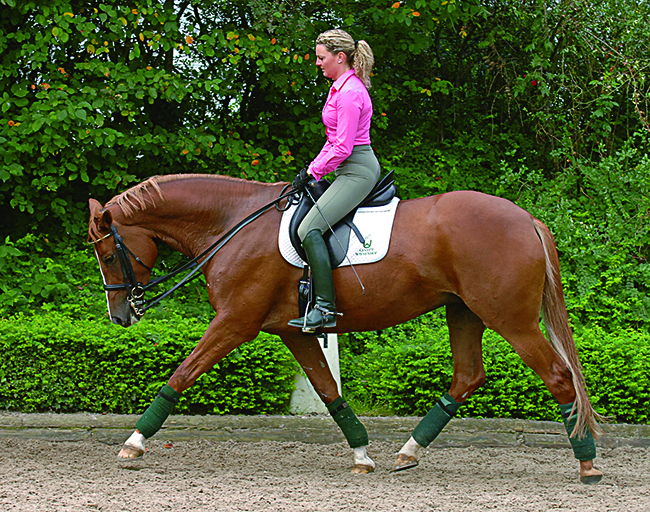



No comments:
Post a Comment